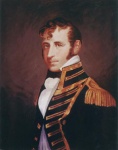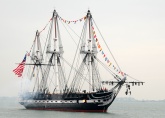The Action of 13 December 1814 was a naval action during the War of 1812. A flotilla of British longboats were on their way to fight the Battle of Lake Borgne. Before reaching the lake, they would encounter an American schooner of the United States Navy.
The Louisiana Campaign had begun, British ships were sailing off the American southern coast, destination New Orleans. The British landing area for the invasion of Louisiana was set for Lake Borgne but in order to land, a squadron of American gunboats and other ships, had to be destroyed. At night, on December 13, 1814, the British set course for the lake.
Alexander Cochrane, of the Royal Navy, ordered Captain Nicholas Lockyer to proceed to the lake with a force of forty-two armed longboats, armed barges, armed launches and three armed gigs. Manned by 1,000 to 1,200 sailors and marines with 8 to 24 pound guns, mounted at the bow of the longboats. The force pushed off from HMS Armide at an unknown time of evening.
American forces, on USS Sea Horse and commanded by Sailing Master William Johnson were on a mission to Bay St. Louis, Mississippi to destroy a store of weapons to prevent its possible capture by the British fleet sailing in the region. Sea Horse was armed with only one 6 pound cannon and had a crew of fourteen men.
Both sailors and artillery were sparse in the then frontier South.
USS Sea Horse had not yet made it to Bay St. Louis when spotted by Captain Lockyer's longboats late at night on December 13, somewhere in a waterway between Lake Borgne and the Bay of St. Louis along the Gulf of Mexico. As soon as Lockyer spotted Sea Horse from a distance, an unknown number of boats were sent in that direction to cut the American schooner off and capture her. At some point, Sailing Master Johnson spotted the Royal Navy boats and attacked.
A brief exchange occurred which resulted in light damage to the American schooner by a couple British shots. Two men were killed and another two wounded. William Johnson then ordered his crew to head for the nearby coastline, protected by an artillery battery. The British vessels followed.
Once drawing the British boat fleet into range of the artillery battery, Sea Horse turned and headed back into battle. The artillery on the coast began firing and the British flotilla retreated. But only for a short while. After fighting off a first British boat attack, Master Johnson felt the coastline under protection of the battery was a good place to anchor his ship until the next morning.
One member of the fourteen man U.S. crew spotted the silently approaching British boats and the alarm was raised. Immediately the crew were ordered to arm themselves with the schooner's issue of muskets, or man the sailing vessel's one gun. The British boats drew close and the Americans opened fire.
Hearing the Sea Horse's fire, the American battery commenced. Accurate fire from the American's small arsenal of weapons proved efficient and another longboat attack was driven off. Captain Lockyer decided to abandon his attempt to capture the Sea Horse and ordered his men to continue on to Lake Borgne.
The British suffered several armed longboats damaged in action and an unknown number of dead and wounded. The United States lost the said two dead and two wounded, as well as minor damage to the schooner. William Johnson, just after his encounter with the British, realized that the enemy fleet was nearby and the capture of his ship by the main Royal Navy fleet was indeed possible. So he ordered his ship to make for the nearest settlement. Once there, near a friendly location to prevent being stranded, Johnson ran his schooner aground on a beach and had her burnt.






 Reply With Quote
Reply With Quote




Bookmarks